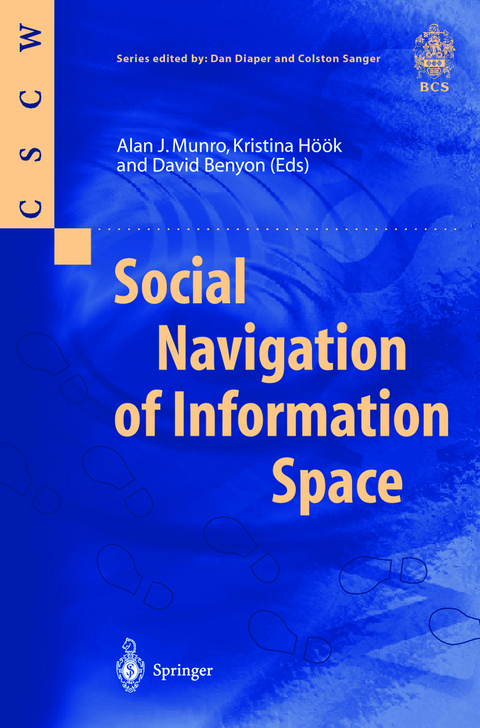
Social Navigation of Information Space
Springer London Ltd (Verlag)
978-1-85233-090-3 (ISBN)
1 Footprints in the Snow.- 1.1 Introduction.- 1.2 Mapping Social Navigation.- 1.3 Shifting Perspective.- 1.4 Social Navigation and Methodology.- 1.5 The Future of Social Navigation.- References.- 2 Where the Footprints Lead: Tracking Down Other Roles for Social Navigation.- 2.1 Introduction.- 2.2 Perspectives on Social Navigation.- 2.3 Spatial, Semantic and Social Navigation.- 2.4 New Opportunities for Social Navigation.- 2.5 Social Navigation and Collaborative Awareness.- 2.6 Social Navigation and Models of Space.- 2.7 Conclusions: New Opportunities for Social Navigation.- References.- 3 Social Connotations of Space in the Design for Virtual Communities and Social Navigation.- 3.1 Introduction.- 3.2 Social Navigation.- 3.3 Open Issues in Social Navigation.- 3.4 Social Connotations in Real and Virtual Spaces.- 3.5 Summary.- References.- 4 Informatics, Architecture and Language.- 4.1 What Underlies HCI?.- 4.2 Space Syntax.- 4.3 Information Structures Seen as Architectural Plans.- 4.4 The Path Model: An Information Access Approach Based on Activity.- 4.5 Conclusion.- References.- 5 Information that Counts: A Sociological View of Information Navigation.- 5.1 Introduction.- 5.2 The Fieldwork and the Setting.- 5.3 The Empirical Examples.- 5.4 Implications for Information Navigation on the Web.- 5.5 Conclusion.- Reference.- 6 Screen Scenery: Transposing Aesthetic Principles from Real to Electronic Environments.- 6.1 Introduction.- 6.2 Electronic Landscapes.- 6.3 The Ethnographic Study.- 6.4 Spatial Grammars.- 6.5 Presence and Orientation in Electronic Environments.- 6.6 Everyday Practices of Orientation and Perception and Spatial Grammars.- 6.7 Conclusion.- References.- 7 Navigating the Virtual Landscape: Co-ordinating the Shared Use of Space.- 7.1 Introduction.- 7.2 Shared Information Spaces.- 7.3 Methodological Approach and Research Setting.- 7.4 Observations.- 7.5 Summary and Conclusions: Co-ordinating the Shared Use of Space.- References.- 8 Spaces, Places, Landscapes and Views: Experiential Design of Shared Information Spaces.- 8.1 Introduction.- 8.2 Personal Spaces versus Public Places.- 8.3 Information Cities, Islands, Vehicles and Views.- 8.4 The Experiential Approach to HCI Design.- 8.5 Presences and Concealment.- 8.6 Conclusions.- References.- 9 The Conceptual Structure of Information Space.- 9.1 Introduction.- 9.2 Study: Users Describe Web Experience.- 9.3 Discussion.- 9.4 Conclusion.- References.- 10 A Contrast Between Information Navigation and Social Navigation in Virtual Worlds.- 10.1 Navigation.- 10.2 Home Hunting.- 10.3 Extension to Digital Representation and Social Navigation.- 10.4 Computer-Assisted Home-Hunting.- 10.5 Social Navigation: Cocktail Party Browsing.- 10.6 Computer-Assisted Remote Acquaintance.- 10.7 Comparisons: Information vs Social Navigation.- 10.8 Conclusions.- References.- 11 Understanding Representations of Space: A Comparison of Visualisation Techniques in Mainstream Cinema and Computer Interfaces.- 11.1 Introduction and Some Distinctions.- 11.2 Understanding Cinematic vs Digital Representations.- 11.3 Concluding Comments.- References.- 12 The Role of Wearables in Social Navigation.- 12.1 Introduction.- 12.2 Defining a Wearable.- 12.3 Wearables and Social Navigation.- 12.4 Augmentation.- 12.5 Time-Space Trajectories.- 12.6 Wearables in Context.- 12.7 Future Work.- 12.8 Summary — Creating Cultural Footprints.- References.- 13 Evaluating Adaptive Navigation Support.- 13.1 Introduction.- 13.2 Adaptive Navigation Systems.- 13.3 Evaluations of Adaptive Navigation Systems.- 13.4 Evaluation Criteria.- 13.5Summary.- References.- 14 Footsteps from the Garden — Arcadian Knowledge Spaces.- 14.0 Introduction: Personal and Social Navigation in Shared “Organic” Landscapes.- 14.2 Information Finding, Memory and Social Navigation.- 14.3 From Applications to Agents — Ecologies in the Interface.- 14.4 Organic Metaphors.- 14.3 The Knowledge Garden.- 14.4 (By Way of Some) Conclusions.- References.
| Erscheint lt. Verlag | 13.8.1999 |
|---|---|
| Reihe/Serie | Computer Supported Cooperative Work |
| Zusatzinfo | 32 Illustrations, black and white; XIV, 278 p. 32 illus. |
| Verlagsort | England |
| Sprache | englisch |
| Maße | 155 x 235 mm |
| Themenwelt | Mathematik / Informatik ► Informatik ► Betriebssysteme / Server |
| Mathematik / Informatik ► Informatik ► Netzwerke | |
| Informatik ► Software Entwicklung ► User Interfaces (HCI) | |
| Sozialwissenschaften ► Kommunikation / Medien ► Kommunikationswissenschaft | |
| ISBN-10 | 1-85233-090-2 / 1852330902 |
| ISBN-13 | 978-1-85233-090-3 / 9781852330903 |
| Zustand | Neuware |
| Haben Sie eine Frage zum Produkt? |
aus dem Bereich


